Papers by somayeh Noori Hekmat
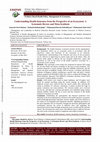
Evidence based health policy, management and economics, Mar 28, 2022
Background: The health insurance ecosystem involves all the organizations and institutions which ... more Background: The health insurance ecosystem involves all the organizations and institutions which act as ecosystem actors in accordance with the objectives, values and functions of the ecosystem as its elements. Comprehensive understanding of the elements and actors of this ecosystem can be effective in improving its current status and in the future. Thus, the present study aimed to discuss the key elements (objectives, values and functions), as well as the actors of the health insurance ecosystem by a systematic review method. Methods: This systematic review study was conducted in January 2021 using the six-step Walsh and Downe technique in the form of meta-synthesis. The question proposed a search strategy using the SPIDER framework, and the search was done in PubMed, Scopus, Web of Science ,Cochrane and Persian database of Magiran without considering a specific time and place. Content analysis method and MAXQDA 2020 were used to combine the findings. the Mixed Methods Appraisal Tool (MMAT) evaluation checklist version 2018 was used to evaluate quality of studies. Results: 1410 articles were found in major databases, and 10 papers were found by manual searching using the search strategy. In addition, 612 duplicate records were removed from the search results after entering the results in EndNote X7 software. Ultimately, 9 studies reached the stage of quality evaluation and meta-synthesis. The selected studies were reviewed one by one, and their key concepts and themes were identified using content analysis method. Finally, the list of actors and key elements of the health insurance ecosystem was made. Conclusion: Establishing fair participation and financial protection were identified as the most important key elements in the health insurance ecosystem, achieved through governance functions, resource supply, and service delivery in the context of an integrated and transparent structure. Applying governance is the most important role of ecosystem, forming the necessary participation and coordination between the actors in different roles, and regulating the interactions between them through mechanisms such as tariffs and the payment system. The role played by many actors with different roles or different roles by one actor in the ecosystem results in complexity and conflict of interest.

BMC Medical Education, May 26, 2022
Introduction: The faculty promotion system is expected to benefit the faculty, institute, and pro... more Introduction: The faculty promotion system is expected to benefit the faculty, institute, and profession and lead to the sustainable and comprehensive development. This present systematic review aims to investigate the challenges and solutions for the promotion of medical sciences faculty members in Iran. Method: This study was a systematic review conducted by searching in PubMed, Scopus, Eric, Web of Science, Cochrane, SID, Magiran, and https:// irand oc. ac. ir/ line with Persian and English terms in the period from 2015 to 2020. Study selection and data extraction were performed independently by reviewers. Results: Thirteen articles were included. Challenges and solutions for the promotion of medical sciences faculty members were reviewed and grouped into five main categories: 1. The general regulations for the promotion of faculty members, 2. Cultural, disciplinary, and social activities, 3. Educational activities, 4. Research-technology activities, and 5. Scientific-executive activities. Conclusion: Despite several modifications to regulations for the promotion of medical sciences faculty members in Iran, this process still encounters challenges because of its complex nature. This article provides tips to policymakers on regulations of promotion for educational activities.

Introduction: Hospitals are the most expensive health care organizations. In this study, identify... more Introduction: Hospitals are the most expensive health care organizations. In this study, identifying factors influencing hospitalization costs based on the three aspects of the health system including patients, health care providers, and insurance organizations were considered. Methods: This was a qualitative and phenomenological study. In this study, 12 experts in the field of management and controlling hospital's costs were selected through purposive and snowball sampling method. Data were collected using focused group discussion. Framework analysis was used for data analysis. Results: The factors affecting hospitalization costs were classified into three codes including patients, health care providers, and insurance organizations. Lack of knowledge and awareness and neglecting self-care were the main patient-related factors, and weak management and supervision, lack of medical guidelines, long-term recovery period, lack of implementation of family physician and weak commitments and structural problems of insurance organizations were the main factors related to the health care providers and insurance organizations. Conclusion: The results showed that by increasing and improving self-care programs, providing health-oriented services, implementation of family physician program, specializing the hospital management, improving the quantity and quality of supervisions and reforming expert structure of insurance organizations, the hospitalization costs can be managed.
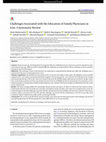
Journal of Medical Education
Context: Nearly 20 years ago, the family physician program (FPP) was established in Iran in rural... more Context: Nearly 20 years ago, the family physician program (FPP) was established in Iran in rural areas and was expanded to some cities about 10 years ago. Different studies reported different challenges associated with the efficacy of human resources and their training or educational program. Objectives: This systematic review of the literature was conducted to comprehensively identify and collate the challenges associated with the education of family physicians in Iran. Evidence Acquisition: All published articles related to FPP in Iran were the subject of this study. The eligibility criteria included original articles, case studies, and reports published in English or Persian during 2011 - 2021 related to the challenges in the training and educational system of FPP in Iran. Data were extracted based on the SPIDER (sample, phenomenon of interest, design, evaluation, research type) technique and were reported based on the structure of PRISMA (preferred reporting items for systemati...
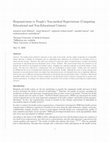
objective: The health system should be responsive to the needs of the clients, and the regular mo... more objective: The health system should be responsive to the needs of the clients, and the regular monitoring of accountability system will help to identify the weaknesses and, by eliminating these deficiencies the motivation for providing services to clients will also increase. Therefore, this study was conducted to assess the status of responsiveness to people's non-medical expectations in educational and non-educational centers of Iran. Methods: This cross-sectional study was conducted on 112 patients who referred to the hospitals and medical centers. Sampling was conducted randomly on all clients during a 15-day period. The data were collected by a questionnaire that was standardized in similar studies. Finally, data were analyzed by SPSS23 and the scores of responsiveness dimension were measured. Results: Although the scores of many responsiveness dimensions in non-educational centers were higher than educational centers, but ultimately there was no significant difference between the scores of different responsiveness dimensions in educational and non-educational centers. Conclusion: Educational and public health centers need more attention compared to non-educational centers to improve responsiveness to people's nonmedical expectations. According to the obtained results, the priority of the actions is focused on providing the required human resources.
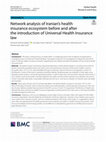
Global Health Research and Policy, May 22, 2023
Introduction The policy-making process in health reform is challenging due to the complexity of o... more Introduction The policy-making process in health reform is challenging due to the complexity of organizations, overlapping roles, and diversity of responsibilities. The present study aims to investigate and analyze the network of actors in the Iran health insurance ecosystem regarding the laws before and after the adoption of the Universal Health Insurance (UHI). Methods The present study was done by sequential exploratory mixed method research, consisting of two distinct phases. During the qualitative phase, the actors and issues pertaining to the laws of the Iranian health insurance ecosystem from 1971 to 2021 were identified through a systematic search of the laws and regulations section of the Research Center of the Islamic Legislative Assembly website. Qualitative data was analyzed in three steps using directed content analysis. During the quantitative phase, in order to draw the communication network of the actors in Iran's health insurance ecosystem, the data related to the nodes and links of the networks was collected. The communication networks were drawn using Gephi software and the micro-and macro-indicators of network were calculated and analyzed. Results There were 245 laws and 510 articles identified in the field of health insurance in Iran from 1971 to 2021. Most of the legal comments were on financial matters and credit allocation, and the payment of premiums. The number of actors before and after the enactment of the UHI Law was 33 and 137, respectively. The Ministry of Health and Medical Education and the Iran Health Insurance Organization were found the two main actors in the network before and after the approval of this law. Conclusions Adopting a UHI Law and delegating various legal missions and tasks, often with support to the health insurance organization, have facilitated the achievement of the law objectives. However, it has created a poor governance system and a network of actors with low coherence. Based on the results of the study, it is suggested to reduce actor roles and separate them for better governance and to prevent corruption in health insurance ecosystem. Introducing knowledge and technology brokers can be effective in strengthening governance and filling the structural gaps between actors.
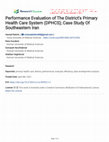
Background: Managers need to measure and evaluate the performance of their subordinates in order ... more Background: Managers need to measure and evaluate the performance of their subordinates in order to plan, organize, and improve the performance of their organizations. In this study, the performance and e ciency of the district's primary health care system in the southeast of Iran were evaluated using the data envelopment analysis (DEA) model. Methods: The quantitative non-parametric data envelopment analysis was used to evaluate the performance of the primary care system in the districts. On the hand, human forcess, physical facilities, and vehicles were the variables used as the inputs, and the number of services and service recipients was considered as the outputs to measure e ciency. The data were analyzed using the DEAP software, and performance and e ciency were calculated with the output maximization approach and the assumption of variable returns to scale. It was carried out as linear programming with nine scenarios for nine districts in 2018. Results: The mean e ciency of the studied districts with the assumption of variable returns to scale was 0.76, indicating at least 24% capacity to increase e ciency in the primary care system of Kerman University of Medical Sciences without any increase in production factors. According to the mean values, Kerman and Kuhbanan were e cient while the other 7 districts were ine cient. The districts were divided into three groups: e cient, moderately e cient, and ine cient. Accordingly, the most ine cient primary health care systems were those of Shahr-e Babak, Baft, and Orzooieh. Conclusion: The results of this study showed ine ciency in most primary health care systems of the studied districts, indicating that primary care managers can provide more health services to the community through proper management of available resources. Ine cient districts can compare themselves with successful and reference districts and eliminate their shortcomings in order to improve their performance.
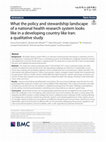
Health Research Policy and Systems, Oct 28, 2022
Background: The health research system (HRS) is an important national priority that requires a sy... more Background: The health research system (HRS) is an important national priority that requires a systematic and functional approach. Evaluating the HRS of Iran as a developing country and identifying its challenges reveals the stewardship-related role in how the whole system is operating well. This study aims to assess the HRS in terms of stewardship functions and highlight the enhancement points. Methods: This study was carried out between March 2020 and April 2021 using a systematic review and metasynthesis of evidence to examine the Iranian HRS stewardship challenges and interview 32 stakeholders, using a critical case sampling and snowballing approach which included both semi-structured and in-depth interviews. The interviewees were selected based on criteria covering policy-makers, managers, research bodies and nongovernmental organizations (NGOs) in health research-related fields like higher education, research, technology, innovation and science. All data were analysed using content analysis to determine eight main groups of findings under three levels: macro, meso, and micro. Results: Analysis of the findings identified eight main themes. The most critical challenges were the lack of an integrated leadership model and a shared vision among different HRS stakeholders. Their scope and activities were often contradictory, and their role was not clarified in a predetermined big picture. The other challenges were legislation, priority-setting, monitoring and evaluation, networking, and using evidence as a decision support base. Conclusions: Stewardship functions are not appropriately performed and are considered the root causes of many other HRS challenges in Iran. Formulating a clear shared vision and a work scope for HRS actors is critical, along with integrating all efforts towards a unified strategy that assists in addressing many challenges of HRS, including developing strategic plans and future-oriented and systematic research, and evaluating performance. Policy-makers and senior managers need to embrace and use evidence, and effective networking and communication mechanisms among stakeholders need to be enhanced. An effective HRS can be achieved by redesigning the processes, regulations and rules to promote transparency and accountability within a well-organized and systematic framework.

Global Journal of Health Science, Apr 29, 2016
The Hospital Information system (HIS) is a comprehensive solution that offers complete data integ... more The Hospital Information system (HIS) is a comprehensive solution that offers complete data integration for different administrative levels in hospitals. To the extent that this system is close to its aim, the efficiency and quality of health care would increase in hospitals. The performance of HIS systems in 13 hospitals in Kerman province that they were evaluated based on four major criteria of ownership, location, education and software design. Seven hospitals were located in the capital city of Kerman province. According to teaching status of hospitals, four were teaching and based on their ownership three were public. The checklist of Iranian ministry of health and medical education, containing 20 indexes were used to evaluate each hospital's HIS system in three main supportive, diagnosis and clinical sectors. Spearman correlation coefficient was used to assess the association between major sectors. The highest score (mean±SD) was observed in laboratory information systems (88.19±13.69), resource management (84.47±8.94), and registration information systems (84.47±18.06); the lowest scores were for telemedicine (45.58±3.86), staff information and timing systems (40±16.64), and decision support systems (23.6±4.97). The total score of HIS software was positively correlated with all its three components. There were strong positive correlations between all three components. The three factors of decision support systems, staff information systems and telemedicine have an important role in providing solutions for non-structured management problems and for leading decision-makers to insights, improving human resource management and solving the problem of access to services. Thus, based on the survey findings, those three factors need to be improved in the Iranian hospital information system.

Health Scope, Nov 25, 2022
Background: Patient transporters have a significant impact on the rate of atonement and property ... more Background: Patient transporters have a significant impact on the rate of atonement and property of hospital services. They have several duties in hospitals; therefore, managing them and ensuring their abilities plays a significant role in increasing patient satisfaction. Objectives: The present study aimed to evaluate the thrust competencies of patient transporters. Methods: This study was an exploratory mixed method carried out in two phases in 2021. In the first phase, different competencies required for hospital workers were identified by interviews. In the next phase, the status of patient transporters' job competencies was assessed through observation and using a checklist in the teaching hospitals in southeast of Iran. The data from the interviews and the checklist were analyzed using Max QDA 20 and SPSS 22 software, respectively. It should be noted that all interviews were conducted between March 2021 and August 2021. Results: The patient transporter' job skill was divided into the two main categories of common and specialized skills as well as the six sub-categories of communication, esteem, conduct, chastisement, displacement and transfer, and trade notice based on the findings of the qualitative state. According to the findings, sanitarium porters' scored higher in terms of maintaining presentable appearances, cleanliness, and hygiene; however, they received lower scores in terms of fitting the patients before moving them and showing an amicable behavior toward them. Conclusions: The results highlighted the need to strengthen the general and specialized skills of patient transporters by adopting different methods. To this end, it was suggested that training courses should be carried out in order to help patient transporters perform their duties more appropriately. It was also recommended that health system managers should increase their awareness of the important role played by patient transporters in enhancing the efficiency and effectiveness of the hospitals.
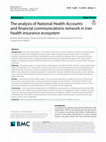
BMC Health Services Research, Dec 20, 2022
Background: One of the major reforms in the health system of any country is the financing reform.... more Background: One of the major reforms in the health system of any country is the financing reform. Network analysis as a practical method for investigating complex systems allows distinguishing prominent actors in the relation networks. Leading to the identification of the effective actors and key links between them, the analysis of financial networks helps policymakers to implement reformations by providing appropriate evidence. This study aimed to design and analyze the network of National Health Accounts (NHA) and the cost network in the Iran health insurance ecosystem. Methods: The present study is a network analysis study based on the data from NHA, and both cost and referral rates that was conducted in 2021. Data, which was for the years 2014 to 2018 and related to NHA, was collected from the Statistical Center of Iran, and cost data and referral rates, which were both related to Basic Insurance Organizations (BIOs), were collected from statistical yearbooks. To analyze the network and identify the key actors, macro indicators, such as network size and density, and micro indicators, such as centrality indicators and the combined importance index, were used. Results: In the financing of the health system in Iran, insurance organizations, as agents and sources of financing, do not have a very good position, so direct payments have become a key element in the network of NHA. Providing treatment-oriented services is quite prior. Regarded to health services, hospitals and outpatient services, such as pharmacies and physicians are the key elements of cost and referral rates respectively. Conclusion: Consisting of several organizations with different insurance policies and being supervised under different ministries, Iran's health financing system lacks a coherent structure. It is suggested to create a coherent insurance system by creating a single governance system and paying more attention to health-oriented instead of treatmentoriented services. The health insurance ecosystem has become a health-oriented system to reduce the direct payments as well as cost management.

Health technology assessment in action, Nov 14, 2022
Background: To improve healthcare services’ quality, countries should measure their health system... more Background: To improve healthcare services’ quality, countries should measure their health systems’ efficiency and performance by robust methods. Objectives: We aimed to develop a national study to measure the efficiency of the health system in Iran. Methods: The literature review identified several methods for measuring efficiency; the most common one was data envelopment analysis (DEA). We adopted DEA, but its findings were simplistic and inaccurate, so we began to modify the method by determining the weight of each indicator. We identified the efficiency measurement indicators, in line with international standards and uniformed units, and then readjusted our input/output indicators according to the study context through four expert panels. We collected data and classified the input/output indicators, followed by determining each indicator’s weight and standard limits. Then we rationalized our previous results by applying the revised model. The initial new results of the refined model were valid, accurate, and consistent with previous studies, as approved by experts. We defined proper modeling to achieve the stated objectives. After investigating various DEA models, we finally designed a new model that was consistent with the existing data and conditions, entitled EDEA (extended DEA), to analyze other subprojects. Conclusions: The conventional DEA methods may not be accurate enough to measure health systems’ efficiency. By modifying modeling process, we propose a modified DEA with a very low error rate. We suggest that others interested in measuring health system efficiency adopt our modified approach to increase accuracy and create more meaningful policy-oriented results.
future of medical education journal, Dec 1, 2019

BMC Health Services Research, Aug 23, 2022
Background: Fair access to health services is a vital issue in low-and middle-income countries. T... more Background: Fair access to health services is a vital issue in low-and middle-income countries. Therefore, the present study was conducted to evaluate the equity in access to primary health care (PHC) services in southeastern Iran. Methods: This household-based survey was conducted on 1128 households in Kerman, southeastern Iran in 2019-20. A multistage probability method was used to select the samples. The online questionnaire was designed and its link was provided to the questioners. After receiving the training, the questioners went to the door according to the sampling guide. The collected data were analyzed at a significance level of 0.05, using the STATA software. The concentration index (CI) was also used to measure inequality in access to PHC services. Results: The results showed that there was a significant difference between gender and location in access to PHC services (P < 0.05). However, no significant difference was found between the access rates to PHC services and the variables of age, marital, education, health insurance, and Supplementary insurance (P > 0.05). The mean rate of access to PHC services was 3.51 ± 0.53. Cultural access (3.76 ± 0.54) and timely receipt of PHC services (2.51 ± 0.72) accounted for the highest and the lowest access rates, respectively. The concentration index for the distribution of PHC services among the income-adjusted population was 0.014 (CI 95%:-0.022 to 0.051), indicating pro-rich inequalities in access to PHC services. Conclusion: The results indicated that pro-rich inequality, but it was close to the equality line. Also, the access level was assessed as moderate to high. Therefore, planning and policy-making seems essential for reduce inequality, and development and promotion of access to PHC services, especially timely provision of services and organizational access.

British Journal of Healthcare Management, May 2, 2023
This systematic literature review and meta-synthesis aimed to explore the impact of regionalisati... more This systematic literature review and meta-synthesis aimed to explore the impact of regionalisation of hospital services on healthcare costs. The authors searched PubMed, Scopus, EMBASE, EBSCO, Google Scholar, Web of Science and Cochrane Library databases to identify relevant studies, with no limits based on year of publication or country. Search terms included the key words ‘regionalisation’, ‘hospital’ and ‘cost’, along with related terms. Of the 310 identified studies, 37 were included in the final review. A meta-synthesis was carried out to assess the primary outcome measure of costs in regional hospitals, as well as the secondary outcome measures of patient mortality rates, length of stay and accessibility. A total of 28 studies suggested that regional hospitals had lower long-term costs than non-regional hospitals, largely because of the skills and experience of the clinical teams, as well as investment in specialist medical equipment. Other identified benefits were reduced length of stay and lower patient mortality rates. However, some studies indicated that regionalisation did not entirely eliminate problems relating to patient access, with implications for further study and policy considerations.

Research Square (Research Square), Dec 18, 2019
Background Iran has performed Health Transformation Plan(HTP) from 2014 to obtain its de ned goal... more Background Iran has performed Health Transformation Plan(HTP) from 2014 to obtain its de ned goals. This study assesses and compares the e ciency and productivity of university and non-university hospitals in Kerman provinces, Iran. Methods The data of 19 selected hospitals, two years before and two years after the Health Transformation Plan was collected in this cross-sectional study. These data included the variables of physician and nurse number, and active beds as inputs and bed occupancy rate and inpatient admission adjusted with the length of stay as outputs. Data Envelopment Analysis method used to measure hospital e ciency. Malmquist Productivity Index used to measure e ciency change model before and after the plan. The e ciency was estimated using Deap 2.1 program, and the effect of the plan on e ciency and productivity of hospitals was assessed using Stata 15. Results The results indicated that the average e ciency of all hospitals before the HTP was 0.843 and after the HTP was increased to 0.874. However, this was not signi cant (P>0.05). Productivity also had a decreasing trend. Conclusion Based on the results of the DEA method, it was found that the e ciency and productivity of university and non-university hospitals did not increase signi cantly after the HTP. Therefore, it is recommended that attention should be paid to the performance indicators of hospitals regarding how resources are allocated and decisions made.
iranian journal of epidemiology, Mar 10, 2018
DOAJ (DOAJ: Directory of Open Access Journals), Jul 1, 2014
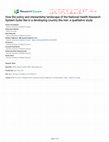
Research Square (Research Square), Apr 13, 2022
Background: The health research system is an important national priority that requires a systemat... more Background: The health research system is an important national priority that requires a systematic and functional approach. Evaluating the HRS of Iran, as a developing country, and identifying its challenges show the signi cant role of the stewardship-related ones in how the whole system is operating well. The study aims to assess the health research system regarding stewardship functions and highlighting the enhancement points. Methods: This study was carried out between March 2020 to April 2021 using a systematic review and meta-synthesizing of evidence to examine the Iranian HRS stewardship challenges and interview 42 stakeholders, using a critical case sampling and snowballing approach that some were semi-structured and some in-depth. The interviewees were selected criteria-based, covering the policymakers, managers, research bodies, and NGOs in health research-related elds like higher education, research, technology, innovation, and science. All data were analyzed using the content analysis leading to determining eight main groups of ndings under three levels of Macro, Meso, and Micro. Results: Analyzing the ndings leads to eight main themes. The most critical challenges were: not forming an integrated leadership model, and a shared vision among different HRS stakeholders. Their scope and activities had contradictions, and their role was not clari ed in a predetermined big picture. The other challenges were in legislation, priority setting, monitoring and evaluation, networking, and using evidence as a decision support base. Conclusion: Stewardship functions are inappropriately performed, and they are considered the root causes of many other HRS challenges in Iran. Formulating a clear shared vision and formulating the work scope for HRS actors is critical, along with integrating all efforts toward a uni ed strategy that assists in addressing many challenges of HRS. Developing strategic plans, future-oriented and systematic research, and evaluating the performances. Policymakers and senior managers need to embrace and use evidence, and effective networking and communication mechanisms among stakeholders need to be enhanced. To have an effective HRS, redesigning the processes, regulations, and rules promotes transparency, accountability, being well-organized and systematic. Contributions To The Literature Having a systematic approach to health research helps in enhancing the research system e ciently, integrated, and practically. Stewardship needs attention as the essential function of a national health research system, especially in a developing country like Iran. The stewardship challenges are the roots of many other malfunctions of an HRS like resource management, knowledge management, capacity building, etc. The ndings can be the basis for further studies and interventions in improving the HRS at the policy making level. A map of an ideal HRS has been imagined to visualize what we need to have a well-organized HRS. Background Health research efforts have received more attention globally during the last two decades, and adopting a systematical approach to the issue has also been improved (1, 2). The starting point that drew attention was the gap between the health research activities and the highest priorities, discussed at the health research conference in Bangkok in 2000 (2). There are two main concepts involved, health research (HR) and HRS. HR refers to knowledge generation methodologically that aims to deal with health problems (3) it is near the second mode of scienti c research. In mode one, the science nds its way, but in mode two, it is supposed to bene t the community socially and economically and improve the development path in practice (4). The second concept is the HRS, called the national health research system (NHRS), when it makes sense at the national level. It architectures the components, and stakeholders active in health research, systematically and more importantly, helps mobilize the resources to address national health needs (5). The HRS has a critical role in health policymaking by generating evidence for addressing the questions (1). As the evidence is highly quali ed, need-based, and accountable, it facilitates the path toward universal health coverage, too (6). Articulating the health system and its subsystems, based on their functions, helps capture the components, relations, and synergies of being systematical (7). The stewardship is an initial function of a health system that helps meet the objectives (8). Stewardship and governance, used changeably in HRS frameworks that are considered as the primary function of an HRS with mostly the same sub-functions (9-11), as follows: 1) Setting vision; 2) Developing National strategic health plan; 3) Performance monitoring; 4) Setting Relations, partnerships, processes, regulations, and rules; 5) Intelligence generation; 6) Ensuring accountability, and 7) Priority setting (2, 5, 12-15). Most of the challenges of the HRSs are rooted in the breakdown of stewardship and governance and related subfunctions (as mentioned above), which is valid for most countries, with more intensity in developing ones (16). Iran HRS is also encountering many malfunctions despite all its improvement in HR in the last three decades (17, 18), so the process of NHRS development has to be redesigned. Most HRS challenges are due to the stewardship malfunction, like a failure of the structural and regulatory framework, processes, and monitoring. Improving the stewardship helps strengthen the NHRS similarly in Iran and other developing countries (11, 16, 19). Our research team consisting of the managers of the health research grant bodies and health-related research center, and researchers, are encountering so many challenges in our daily activities that motivated us to think about the causes and try to nd answers to the questions raised from those challenges. The main question is: how much is Iran's HRS melody harmonious? The rst answer that comes to mind as what we experience is, not so much! Trying to nd the exact and to the point causes and solutions by initial literature review, the answers were not clear and convergent, so each stakeholder blamed the other. Some blame researchers for their non-practical research efforts (20), and others believe that policymakers are not trusted by the nature of the research and the evidence that can help them take their roles more e ciently (21). Meanwhile, others challenge the national health research system and believe that research capabilities are not used as they should be. Reviewing the literature helped us capture the NHRS concept that has received more attention globally during the last two decades. It also helps adopt a systematical approach to the issue (1, 2).
Strides in development of medical education, Aug 18, 2019











Uploads
Papers by somayeh Noori Hekmat
Effort to achieve universal health service coverage has a long history in Iran.
Perhaps the first step in Iran to achieve universal health coverage could be
attributed to about 80 years ago. Actions toward universal health coverage in Iran
initiated after the approval of the railway workers' cautionary funds formation
plan in 1930. From 1930 to 1972, Iran underwent several plans to overcome
problems of health services provision and medical human resources distribution.
Health corps plan, rural paramedic education plan, Selseleh plan in Aleshtar of
Lorestan and research project on how to develop medical and health services
known as Rezaieh plan are important actions in the direction of training and using
non-physician manpower in primary health care provision and better public
access to these services. Between 1981-1987, health care networks plan and
health services leveling was implemented as one of the world’s most successful
experiences regarding public access to health services.
After the approval of the obligation of social security in November 1989, the
responsibility of providing curative services for workers and those subject to
work and social security laws was entrusted to social security organization.
Medical Services Insurance Organization (MSIO) was established in 1995 and
according to the law, provision of health insurance for government employees,
the poor, the villagers, self-employed and other social groups entrusted to this
organization. Social security insurance organization and Iran’s health insurance
organization now cover the majority of the population. Then another step was
taken to provide services for villagers in 2005 when the rural family physician plan
was implemented. Finally, when the government implemented the health system
evolution plan for the first time in the country in 2014, it took a big stride to
achieve different aspects of universal health coverage including reducing out of
pocket payments and trying to improve the quality of service provision at medical
centers.
2
Despite all the efforts done in previous years to ensure universal health coverage
in Iran, Islamic republic of Iran still has a way ahead to achieve this goal. In this
report, universal health coverage had been analyzed on the basis of available data
in four pillars of Coverage, Range, Health service quality and Financial protection
in Islamic republic of Iran.